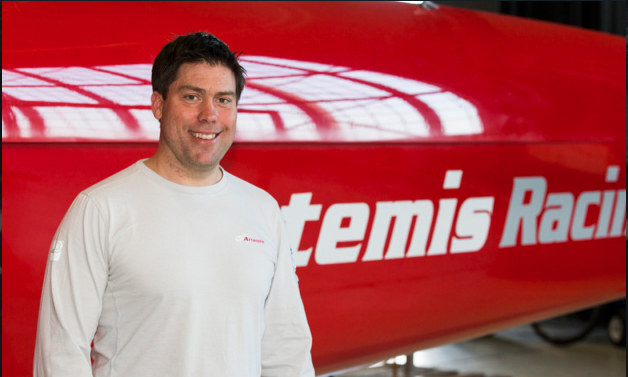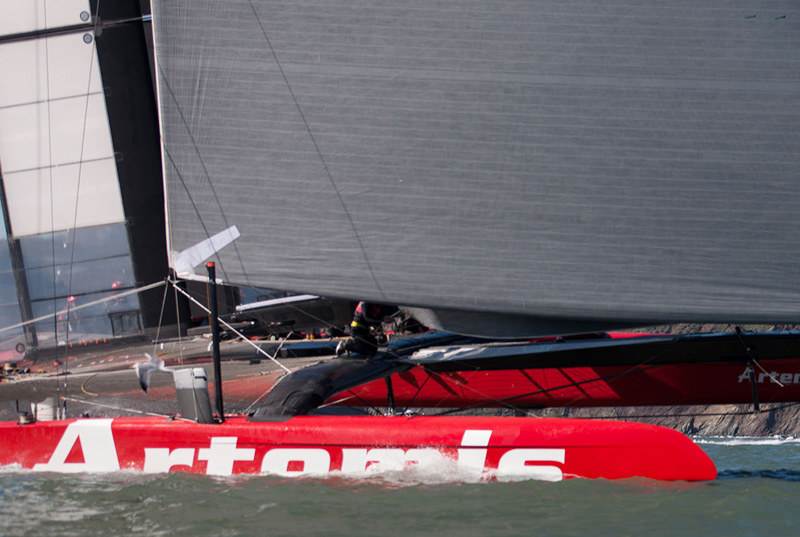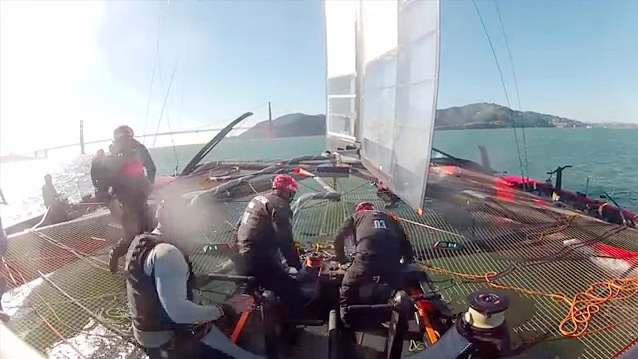
Investigation into Simpson’s Death Continues

“It’s too early to speculate about the causes of the accident," said Chief Executive of the America’s Cup Event Authority (ACEA) Stephen Barclay on Friday, referring to the tragic death of Artemis Racing crewman Andrew ‘Bart’ Simpson the day before. As reported earlier, the 36-year-old British sailor was pinned beneath the wreckage of one of the team’s AC72 catamarans after it suffered a catastrophic breakup at high speed.
"All we know is that the boat ended up capsized, the hulls upside down, broken in half," added America’s Cup Regatta Director Iain Murray. "The split seconds from when the boat was sailing upwind to the pictures that we’ve all seen (of the boat turned upside down and broken apart), there’s a gap in there and that’s what we need to fill in and find out what happened.” Murray is currently spearheading an in-depth investigation into the causes of the breakup, which will involve Artemis staff as well as outside experts. Because the fatality occurred with what is technically considered a ‘recreational’ rather than commercial vessel, the San Francisco Police Department is leading the investigation into Simpson’s cause of death, with the U.S. Coast Guard offering assistance to both the ACEA and the SFPD.

As of Friday, the wreckage of the vessel was in police custody, and statements were being taken from all witnesses. We’re told it is the police department’s mandate to assess whether there was any criminal negligence involved in the incident. It is unclear if video footage exists of the actual break-up of the Artemis AC72. If it does, it has not yet been made public.
In a conversation this morning, Coast Guard Captain Matt Bliven explained that the Coast Guard has offered to act as liaison with the ACEA’s investigating committee, much as they did in the aftermath of last April’s Low Speed Chase incident. Bliven says he is generally impressed with how much attention is focused by the AC teams on safety. "Given the totality of what they are doing, we’re pretty convinced that they are operating safely," he said. "They are making good efforts to keep clear of commercial traffic, and have been notifying us and the Vessel Traffic Service when and where they will be operating." That said, the event permits for this summer’s AC events are not due to be issued until shortly before the actual event dates.
While the edgy, ultra-high-speed nature of AC72 racing was meant to spur Cup enthusiasm from both sailors and non-sailors, Thursday’s accident has caused some Cup-watchers to claim that technical innovations of this new generation of boats are not yet sufficiently tested and refined to be safe, especially in brisk SF Bay conditions. What do you think (briefly)?

No doubt a wide range of opinions and concerns will be expressed tomorrow when representatives from all four AC teams (Oracle Team USA, Artemis Racing, Luna Rossa Challenge and Emirates Team New Zealand) will sit down together for a earnest discussion of the mishap and its consequences. "The meeting with the teams is a crucial next step," Murray said. "We need to establish an open flow of information to ensure this review meets its goals of fact-finding and putting us in a position to recommend changes, if necessary." We expect this will be a closed-door session, and we suspect some strong opinions will be voiced about the viability of AC72s for Cup racing in typical Bay conditions, as there have been critical grumblings — especially from the New Zealanders — for many months. (Naturally, we would love to be a fly on the wall of those sessions.)
As exciting as AC72s are to watch, in light of Simpson’s death we, too, have to wonder if research and development of this new class of boats isn’t still too much in the experimental phase to be ready for competition before a world-wide audience just 51 days from now. Reacting to Thursday’s tragedy, the German team has dropped out of September’s Red Bull Youth America’s Cup (although those races will be aboard seemingly more stable AC45s.) "The death of one sailor is reason enough,” said team founder Oliver Schwall. "We also feel that our decision has to send an important message after this disaster. It’s time (for event organizers) to start thinking."
As we mourn the loss of a great athlete, we also feel empathy for Barkley and Murray as, ultimately, the buck stops with them — we certainly wouldn’t want to be in their shoes right now. Although some critics are vociferously calling for the cancellation or postponement of the Cup, major TV and promotional contracts have been signed, infrastructure is in place, and probably close to a half-billion dollars has been spent by the teams and other so-called stake-holders. Again, we welcome your brief comments on the situation.
